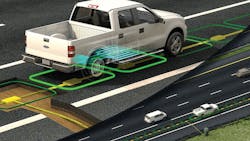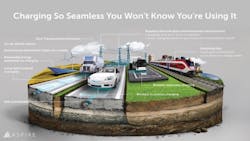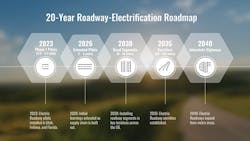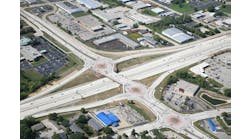Developing an innovative in-pavement charging solution for electric vehicles in Indiana
By: Tim Bruns
Transportation leaders and agencies are constantly trying to keep up with changing times. This includes staying one step ahead of the ever-evolving modes of transportation, as well as accommodating the growing needs and demands of road users.
Examples of this can be seen through the actions of some transportation agencies working to transform their assets and existing infrastructure with vehicle-to-infrastructure and intelligent transportation systems technologies to cater to connected and autonomous vehicles. Others are working on solutions to make it easier for electric vehicles (EVs) to travel greater distances.
One of the goals of the recently passed Infrastructure Investment and Jobs Act (IIJA) is to accommodate the nation’s growing use of EVs by building a network of 500,000 EV charging stations. The new law provides $7.5 billion to transition towards electrification “across all types of vehicles,” according to the White House’s guidebook on the infrastructure law.
Currently, the U.S. has just under 47,000 EV charging stations across the country, according to the most recent data released by the U.S. Department of Energy (U.S. DOE).
While a significant increase in charging stations across the U.S. can go a long way toward broadening the adoption of electric vehicles, some transportation leaders and researchers are looking at solutions that could allow EV users to charge their vehicles without ever stopping or leaving the car.
In July 2021, the Indiana Department of Transportation (INDOT) announced its partnership with Purdue University to develop the “world’s first” highway segment made of contactless wireless-charging concrete pavement. The project aims to use magnetizable concrete to enable EVs to charge as they drive over the pavement.
“When [road users] are looking at electric vehicles vs. non-electric, a big question is how am I going to charge this vehicle and how long will it stay charged,” INDOT Strategic Communications Director Mallory Duncan told Roads & Bridges. “As the world develops and moves toward that electric vehicle, we need to have a solution—and this is one of those solutions.”
INNOVATIVE PARTNERSHIP
The idea for the in-pavement charging solution began with Purdue under the Advancing Sustainability through Powered Infrastructure for Roadway Electrification (ASPIRE) initiative. ASPIRE is an engineering research center funded by the National Science Foundation (NSF) and is a partnership between several universities, led by Utah State University (USU). As part of its mission to advance sustainable, electrified transportation, one of the goals of the ASPIRE research center is to develop EV charging technologies and accelerate the adoption of electric vehicles by eliminating barriers to EV use such as charging access and range.
“We were looking into innovative charging technologies, mainly focused on wireless charging technologies—both in motion and stationary,” Nadia Gkritza, Ph.D., ASPIRE Campus Director and Lyles School of Civil Engineering Professor at Purdue University, told Roads & Bridges. “So we started looking at the technical and economic feasibility as part of a Department of Energy project. That was a project I presented to the INDOT commissioner at one of several networking events.”
The magnetizable concrete solution to enable EV wireless charging is developed by German startup Magment GmbH. After INDOT and Purdue completed a feasibility study for the project, Magment came on board during phase 2 for field implementation of the technology.
The project is funded by the Joint Transportation Research Program, which is the research arm of INDOT.
According to INDOT, work during phases 1 and 2 of the project—which began over the summer—includes pavement testing, analysis, and optimization research that is taking place at Purdue’s West Lafayette campus. Phase 3 is expected to begin in 2023 and will include the construction of a quarter-mile-long test bed. INDOT and Purdue are still looking into possible locations for testing to take place during phase 3, which will test the concrete’s capacity to charge heavy-duty trucks at 200 kilowatts and above.
Once phase 3 is complete, the goal for the project is to construct a 1-mile segment along an interstate highway in Indiana for live traffic use. According to Gkritza, one possible candidate for this 1-mile segment could be I-70, a stretch of highway that is part of the Federal Highway Administration’s Alternative Fuel Corridors Program.
HOW THE TECHNOLOGY WORKS
The wireless charging pavement technology is made up of magnetizable concrete slabs with embedded coils, which serves as the charging unit.
“A high-frequency alternate current creates the magnetic field,” Gkritza said. “Then this field is picked up by a compatible coil on an electric vehicle, which converts it back to electricity and can power the motor directly or charge the battery.”
According to Magment’s website, their magnetizable concrete technology consists of cement and recycled magnetic particles called ferrite, which is sourced from e-waste recyclers.
The team at Purdue has seen efficiencies of up to 95% as a result of combining the magnetizable concrete and specialized coil design during testing and analysis, which Gkritza says makes the technology a promising solution for powering vehicles in motion.
LOOKING AT THE NEED
According to U.S. DOE data, Indiana has approximately 976 EV charging ports at 358 charging station locations across the state. Gkritza noted that the state’s network of charging stations does not come near the numbers of a state like California (which has over 14,000). However, the metric the team uses to compare charging infrastructure across different states is based on how many electric vehicles exist per charger port in Indiana.
“I would say Indiana ranks somewhere in the middle towards the top,” Gkritza said. “We have about 17 EVs per charger port. It’s very comparable with other midwestern states.”
The research team sees the potential for the wireless charging pavement as complementary to an expanding network of EV charging stations, but it could ultimately be useful in areas where charging stations are scarce.
“We want to optimize the network to make sure we don’t invest in too many charging stations that are not utilized most of the time,” Gkritza said. “But at the same time, we’re also screening the network, specifically for Indiana, to identify where we see those charging deserts are and where we can advise INDOT and other states about that. We want to make sure where they invest, it’s utilized. But at the same time, we see charging infrastructure driving adoption.”
Gkritza said the new federal infrastructure law provides an opportunity to expand EV charging infrastructure, but that accessibility to electric vehicles remains a concern.
“We are aware that EVs and the initial cost of owning them is cost prohibitive for some groups,” she said. “So affordability is one of the things we want to look at at [ASPIRE], and how we can make them available to everyone. And that’s where we see more of a second used EV market on the rise.”
ULTIMATE VISION
One of the hopes for INDOT and the state of Indiana is to support projects that deliver the infrastructure needed to accelerate the adoption of electric vehicles.
“In Indiana, we’re the crossroads of America. We have millions of people that come through our state every single day,” Duncan said. “To us, it feels like the perfect place to put something like this for the first time. I think it’s good for people to see that we know that the landscape is changing, and we want to grow along with that. So if the shift is going toward electric vehicles, we need to have something in our infrastructure that supports that, whether you have an electric vehicle or not.”
The ASPIRE research center is overseeing additional projects in other states. The program has received a five-year, $26 million NSF grant, which is renewable up to 10 years and $50.6 million.
In Utah, USU received funding from the state to test and implement high-power stationary wireless charging technology for heavy-duty vehicles as part of a pilot project with the Utah Inland Port Authority in Salt Lake County. According to USU, the technology being tested in this project can provide the energy needed to charge large vehicles such as semitrucks in less than a half hour.
In Florida, the Central Florida Expressway plans to invest in the construction of 1-mile test beds of wireless charging in-motion technology west of Orlando. Similar to the Indiana project, the Central Florida project would use electric coils installed in the roadways to charge electric vehicles.
The state of Michigan also recently announced its own plans to build a wireless in-road charging system on a 1-mile section of road in Detroit. The state is working with Israeli startup Electreon—a member of the ASPIRE program—to lead the design, testing, and implementation of the pilot program. The 1-mile stretch of in-road charging will live within Michigan Central, a mobility innovation district in Detroit, and aims to be operational in 2023.
Since INDOT first announced its contactless wireless-charging concrete pavement project over the summer, ASPIRE has seen growing interest in the technology from other states and partners. The goal is to continue implementation of quarter-mile or half-mile test beds that can grow into longer, corridor-wide implementation of the technology on live roadways.
Ultimately, the testing and implementation of these in-road charging technologies can help ASPIRE achieve its vision of a more sustainable, equitable future for transportation.
About The Author: Bruns is associate editor of Roads & Bridges.







